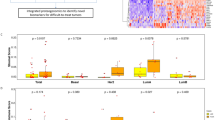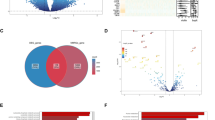Abstract
Purpose
BTB domain-containing 7 (BTBD7) has been found to regulate epithelial tissue remodeling and branched organ formation and has been reported to modulate the biological behavior of several cancers. However, its role in breast cancer has not been identified. This study investigated the biological role and prognostic value of BTBD7 in breast cancer.
Methods
We identified the BTBD7 expression pattern using the GENT2 database and assessed its expression in breast cancer tissue and cell lines using quantitative reverse transcription polymerase chain reaction, western blot, and immunohistochemistry. We conducted a clinical relevance and survival analysis on a cohort of 121 breast cancer cases from our follow-up and validated it in a Kaplan–Meier plotter. The gain–loss effect of BTBD7 on cell proliferation, invasion, and migration was detected in vitro. We employed a xenograft mouse metastatic model for in vivo validation and performed a Cignal Finder Cancer 10-Pathway Reporter Array, western blot, immunofluorescence, Cell Counting Kit-8, and transwell invasion/migration assays to analyze the potential mechanism.
Results
BTBD7 was downregulated in human breast cancer cell lines and tissues. Decreased BTBD7 expression correlated with a positive lymph node status, lymphovascular invasion, and TNM stage, while high BTBD7 expression correlated with low breast cancer recurrence. BTBD7 suppressed cell proliferation, invasion/migration, and tumor metastasis in breast cancer. The mechanism studied suggested that the inhibitory role of BTBD7 was through the deactivation of Notch1 signaling in breast cancer.
Conclusion
BTBD7 suppresses tumor progression, and its high expression correlates with low recurrence in breast cancer.






Similar content being viewed by others
Data availability
The datasets used during the current study are available from the corresponding author upon reasonable request.
Abbreviations
- BTBD7:
-
BTB domain-containing 7
- BC:
-
Breast cancer
- PBC:
-
Peri-tumor tissue of breast cancer
- IDC:
-
Invasive ductal carcinoma
- IHC:
-
Immunohistochemistry
- qRT-PCR:
-
Quantitative Real-time PCR
- ISH:
-
In situ hybridization
- IRS:
-
Immunoreactive score
- ER:
-
Estrogen receptor
- PR:
-
Progesterone receptor
- Her2:
-
Human Epidermal Growth Factor Receptor type 2
- TNM:
-
Tumor node metastasis
- OS:
-
Overall Survival
- RFS:
-
Recurrence-Free Survival
- GENT:
-
Gene Expression database of Normal and Tumor tissues
- FC:
-
Fold change
- DMSO:
-
Dimethylsulfoxide
- N1ICD:
-
Notch1 intracellular domain
- FUP1:
-
Function-unknown protein 1
References
Bray F, Ferlay J, Soerjomataram I, Siegel RL, Torre LA, Jemal A (2018) Global cancer statistics 2018: GLOBOCAN estimates of incidence and mortality worldwide for 36 cancers in 185 countries. CA Cancer J Clin 68(6):394–424
Weigelt B, Peterse JL, van VL (2005) Breast cancer metastasis: markers and models. Nat Rev Cancer 5(8):591–602
Eckhardt BL, Francis PA, Parker BS, Anderson RL (2012) Strategies for the discovery and development of therapies for metastatic breast cancer. Nat Rev Drug Discov 11(6):479–497
Perez-Torrado R, Yamada D, Defossez P (2006) Born to bind: the BTB protein–protein interaction domain. BioEssays 28(12):1194–1202
Chaharbakhshi E, Jemc JC (2016) Broad-complex, tramtrack, and bric-à-brac (BTB) proteins: Critical regulators of development. Genesis 54(10):505–518
Ito N, Watanabe-Matsui M, Igarashi K, Murayama K (2009) Crystal structure of the Bach1 BTB domain and its regulation of homodimerization. Genes Cells 14(2):167–178
Onodera T, Sakai T, Hsu JCF, Matsumoto K, Chiorini JA, Yamada KM (2010) Btbd7 Regulates Epithelial Cell Dynamics and Branching Morphogenesis. Science 329(5991):562–565
Daley WP, Matsumoto K, Doyle AD, Wang S, DuChez BJ, Holmbeck K, Yamada KM (2017) Btbd7 is essential for region-specific epithelial cell dynamics and branching morphogenesis in vivo. Development 144(12):2200–2211
Ewald AJ, Huebner RJ, Palsdottir H, Lee JK, Perez MJ, Jorgens DM, Tauscher AN, Cheung KJ, Werb Z, Auer M (2012) Mammary collective cell migration involves transient loss of epithelial features and individual cell migration within the epithelium. J Cell Sci 125(Pt 11):2638–2654
Varner VD, Nelson CM (2014) Cellular and physical mechanisms of branching morphogenesis. Development 141(14):2750–2759
Hanahan D, Weinberg RA (2011) Hallmarks of cancer: the next generation. Cell 144(5):646–674
Tao YM, Huang JL, Zeng S, Zhang S, Fan XG, Wang ZM, Yang HX, Yuan XH, Wang P, Wu F, Luo J, Zeng DY, Shen H (2013) BTB/POZ domain-containing protein 7: epithelial-mesenchymal transition promoter and prognostic biomarker of hepatocellular carcinoma. Hepatology 57(6):2326–2337
Fan C, Miao Y, Zhang X, Liu D, Jiang G, Lin X, Han Q, Luan L, Xu Z, Wang E (2014) Btbd7 contributes to reduced E-cadherin expression and predicts poor prognosis in non-small cell lung cancer. Bmc Cancer 14:704
Yang L, Wang T, Zhang J, Wang X (2017) BTBD7 silencing inhibited epithelial- mesenchymal transition (EMT) via regulating Slug expression in human salivary adenoid cystic carcinoma. Cancer Biomark 20(4):461–468
Liu Y, Song J, Zhang J, Yang L, Liu Z, Wang X (2018) BTB/POZ domain-containing protein 7 is inversely associated with fibronectin expression in salivary adenoid cystic carcinoma. Oral Surgery, Oral Medicine, Oral Pathology and Oral Radiology 125(5):468–477
Shu J, Wang L, Han F, Chen Y, Wang S, Luo F (2019) BTBD7 Downregulates E-Cadherin and Promotes Epithelial-Mesenchymal Transition in Lung Cancer. Biomed Res Int 2019:5937635
Hayes DF, Ethier S, Lippman ME (2006) New guidelines for reporting of tumor marker studies in breast cancer research and treatment: REMARK. Breast Cancer Res Tr 100(2):237–238
McShane LM, Altman DG, Sauerbrei W, Taube SE, Gion M, Clark GM (2006) REporting recommendations for tumor MARKer prognostic studies (REMARK). Breast Cancer Res Tr 100(2):229–235
Altman DG, McShane LM, Sauerbrei W, Taube SE (2012) Reporting Recommendations for Tumor Marker Prognostic Studies (REMARK): explanation and elaboration. Plos Med 9(5):e1001216
Park S, Yoon B, Kim S, Kim S (2019) GENT2: an updated gene expression database for normal and tumor tissues. Bmc Med Genomics 12(S5)
Robinson DR, Kalyana-Sundaram S, Wu YM, Shankar S, Cao X, Ateeq B, Asangani IA, Iyer M, Maher CA, Grasso CS, Lonigro RJ, Quist M, Siddiqui J, Mehra R, Jing X, Giordano TJ, Sabel MS, Kleer CG, Palanisamy N, Natrajan R, Lambros MB, Reis-Filho JS, Kumar-Sinha C, Chinnaiyan AM (2011) Functionally recurrent rearrangements of the MAST kinase and Notch gene families in breast cancer. Nat Med 17(12):1646–1651
Li L, Guturi K, Gautreau B, Patel PS, Saad A, Morii M, Mateo F, Palomero L, Barbour H, Gomez A, Ng D, Kotlyar M, Pastrello C, Jackson HW, Khokha R, Jurisica I, Affar EB, Raught B, Sanchez O, Alaoui-Jamali M, Pujana MA, Hakem A, Hakem R (2018) Ubiquitin ligase RNF8 suppresses Notch signaling to regulate mammary development and tumorigenesis. J Clin Invest 128(10):4525–4542
Pan W, Zhang Q, Xi Q, Gan R, Li T (2001) FUP1, a Gene Associated with Hepatocellular Carcinoma, Stimulates NIH3T3 Cell Proliferation and Tumor Formation in Nude Mice. Biochem Bioph Res Co 286(5):1033–1038
Fang L, Zhang J, Liu L, Fu W, Shu J, Feng J, Liang X (2017) Silencing of Btbd7 Inhibited Epithelial-Mesenchymal Transition and Chemoresistance in CD133+ Lung Carcinoma A549 Cells. Oncology Research Featuring Preclinical and Clinical Cancer Therapeutics 25(5):819–829
Grisard E, Coan M, Cesaratto L, Rigo I, Zandonà L, Paulitti A, Andreuzzi E, Rampioni Vinciguerra GL, Poletto E, Del Ben F, Brisotto G, Biscontin E, Turetta M, Dassi E, Mirnezami A, Canzonieri V, Vecchione A, Baldassarre G, Mongiat M, Spizzo R, Nicoloso MS (2019) Sleeping beauty genetic screen identifies miR-23b:BTBD7 gene interaction as crucial for colorectal cancer metastasis. Ebiomedicine 46:79–93
Li L, Tang P, Li S, Qin X, Yang H, Wu C, Liu Y (2017) Notch signaling pathway networks in cancer metastasis: a new target for cancer therapy. Med Oncol 34(10)
Nowell CS, Radtke F (2017) Notch as a tumour suppressor. Nat Rev Cancer 17(3):145–159
Sahlgren C, Gustafsson MV, Jin S, Poellinger L, Lendahl U (2008) Notch Signaling Mediates Hypoxia-Induced Tumor Cell Migration and Invasion. P Natl Acad Sci Usa 105(17):6392–6397
Sethi N, Dai X, Winter CG, Kang Y (2011) Tumor-Derived Jagged1 Promotes Osteolytic Bone Metastasis of Breast Cancer by Engaging Notch Signaling in Bone Cells. Cancer Cell 19(2):192–205
Wieland E, Rodriguez-Vita J, Liebler SS, Mogler C, Moll I, Herberich SE, Espinet E, Herpel E, Menuchin A, Chang-Claude J, Hoffmeister M, Gebhardt C, Brenner H, Trumpp A, Siebel CW, Hecker M, Utikal J, Sprinzak D, Fischer A (2017) Endothelial Notch1 Activity Facilitates Metastasis. Cancer Cell 31(3):355–367
Leong KG, Niessen K, Kulic I, Raouf A, Eaves C, Pollet I, Karsan A (2007) Jagged1-mediated Notch activation induces epithelial-to-mesenchymal transition through Slug-induced repression of E-cadherin. J Exp Med 204(12):2935–2948
Li X, Cao Y, Li M, Jin F (2018) Upregulation of HES1 Promotes Cell Proliferation and Invasion in Breast Cancer as a Prognosis Marker and Therapy Target via the AKT Pathway and EMT Process. J Cancer 9(4):757–766
Rashid OM, Nagahashi M, Ramachandran S, Dumur CI, Schaum JC, Yamada A, Aoyagi T, Milstien S, Spiegel S, Takabe K (2013) Is tail vein injection a relevant breast cancer lung metastasis model? J Thorac Dis 5(4):385–392
Acknowledgements
We thank Prof. Zun-fu Ke (Department of Pathology, the First Affiliated Hospital of Sun Yat-sen University) and his colleagues for the help of pathological diagnoses and guidance.
Funding
This study was funded by National Natural Science Foundation of China (No. 81802599).
Author information
Authors and Affiliations
Corresponding author
Ethics declarations
Conflict of interest
All authors declare no conflict of interest.
Ethical approval
All applicable international, national, and institutional guidelines for the care and use of animals were followed. All of the animal experiments were approved by the Institutional Animal Care and Use Committee of Sun Yat-sen University. All procedures performed in studies involving human participants were in accordance with the ethical standards of the institutional and/or national research committee and with the 1964 Helsinki declaration and its later amendments or comparable ethical standards. All human-related procedures were performed with the approval of the Internal Review and the Ethics Boards of the First Affiliated Hospital, Sun Yat-sen University.
Informed consent
Informed consent was obtained from all individual participants included in the study.
Additional information
Publisher's Note
Springer Nature remains neutral with regard to jurisdictional claims in published maps and institutional affiliations.
Electronic supplementary material
Below is the link to the electronic supplementary material.
Rights and permissions
About this article
Cite this article
Chen, J., Lai, YH., Ooi, S. et al. BTB domain-containing 7 predicts low recurrence and suppresses tumor progression by deactivating Notch1 signaling in breast cancer. Breast Cancer Res Treat 184, 287–300 (2020). https://doi.org/10.1007/s10549-020-05857-2
Received:
Accepted:
Published:
Issue Date:
DOI: https://doi.org/10.1007/s10549-020-05857-2




